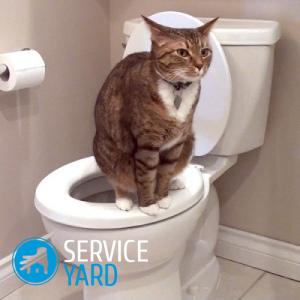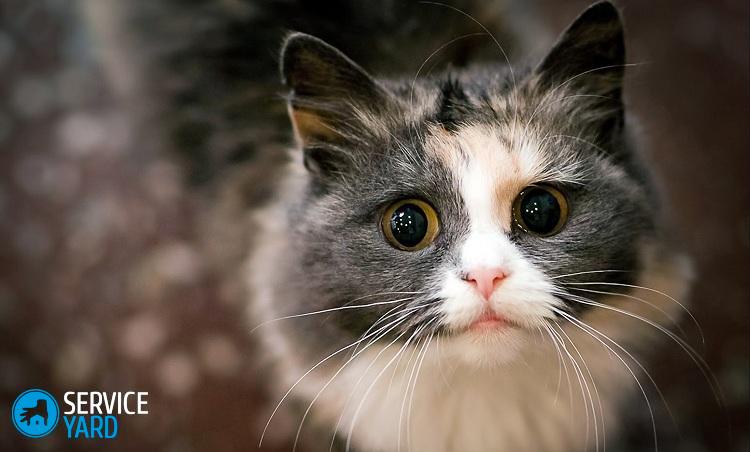The cat feces with blood - what does it mean?

When cleaning a cat's toilet, you may notice that blood has appeared in the excrement of the pet. This is not such a rare problem, veterinarians are constantly confronted with it. Blood clots or, even worse, a bloody puddle in a tray is a sign of a serious pathology in the animal. In no case can you expect that the situation will resolve itself. It is necessary to understand the causes of this phenomenon and provide the animal with timely help. So, cat feces with blood - what does it mean?
to contents ↑Causes
Normal cat feces do not contain bloody or mucous impurities, residues of undigested feed. Blood in excrement is a sign of serious animal health problems. The reasons that provoked this may be the following.
Extremely dry diet
Coarse feed particles injure the mucous membranes of the digestive system. Even worse, if the animal does not have constant access to water. The appearance of extravasates in feces is inevitable.
Chronic constipation
An unbalanced diet, small amounts of water consumed, and eating “human” food sooner or later lead to constipation. Hardened feces injure the colon, causing bleeding after bowel movements.
Foreign bodies
If a pet accidentally swallows a sharp object, then a threatening health situation may develop. Urgently contact the veterinarian!
Parasites
Most helminths parasitizing in the intestines of cats have devices with which they are fixed on the walls of the intestines. The mucous membrane is injured, which leads to the fact that the cat feces with blood.
Important! Do harm to the intestines of the animal and protozoa. They increase the permeability of blood vessels.
The defeat of viruses and bacteria
The cause of the appearance of blood in the bowel movements is infectious diseases (panleukopenia, enteritis, etc.). In addition to diarrhea with an admixture of blood, these diseases are manifested by a sharp deterioration in the condition of the animal, dehydration, and severe vomiting.
Other reasons:
- Diseases of the digestive system, liver, pancreas.
- Chronic inflammation of the large intestine (colitis). One of the manifestations of the disease is erosion and ulcers on the intestinal mucosa. From here - and feces with blood from the cat, and the appearance of mucus in it.
- Polyps. These benign neoplasms of the intestine are quite common. Fecal masses that pass through the intestines injure the overgrown sections of the mucosa, which leads to bleeding.
- Malignant tumors. For cats, colorectal cancer is a rarity, but you still need to exclude this formidable pathology. Only a specialist can do this. Cancer develops gradually, gradually, manifesting itself even when metastases spread throughout the body.
- Blood coagulation disorders, allergies.
- Poison poisoning for rodents. The reason may be rodent hunting or direct contact with poison. It is no coincidence that experienced cat-traps do not eat their prey, but put it on the threshold as a hunting trophy. And young inexperienced animals often die.
- Wool swallowed by the animal during licking often becomes the cause of extravasation in the feces. Most often, this problem occurs with long-haired handsome men. Hair injures the intestinal mucosa, causing bleeding.
- Tubular bones in a cat's diet.Sharp bones injure the intestines, which leads to the appearance of extarvasate in the feces.
- Dysbacteriosis In addition to feces with blood, in a cat this condition is manifested by bloating, an alternation of diarrhea and constipation.
As you can see, there are many reasons for the same phenomenon. Answers to the question, the cat feces with blood - what does this mean, also a lot. For this reason, it is necessary to take the symptoms seriously and not neglect the visit to the veterinarian.
to contents ↑Cause for concern
It is necessary to consult a veterinarian if the animal has the following symptoms:
- The cat pushes hard during bowel movements, meows.
- Blood appeared in the feces of the pet.
What to do before visiting a veterinarian?
Before you go to the veterinary clinic, watch your pet. Pay special attention to such points:
- How often does blood appear in the feces of a cat.
- The amount excreted in the bowel movements.
- The behavior of the animal when visiting the tray (meowing, anxiety).
- The presence of other extraneous inclusions in the feces - undigested feed, wool, mucus, etc.
- Changes in the general condition (activity, presence or absence of vomiting, loose stools, fever).
- Changes in appetite.
Important! Be prepared to answer questions from your doctor, such as:
- changes in the diet of the animal;
- availability of access to poison for rodents;
- the possibility of foreign bodies entering the animal’s body.
All this will allow the doctor to make the correct diagnosis and save the health, and sometimes the life of the animal.
to contents ↑Diagnostics
Before prescribing treatment, the veterinarian carefully examines the pet. The animal is prescribed such tests:
- Detailed blood test.
- The study of feces on protozoa and helminths.
- Examination of feces for occult blood.
to contents ↑Important! A lot of information gives a coprogram. This technique makes it possible not only to study the composition of feces, but also to find hidden blood in it. X-ray diagnostics, ultrasound of the abdominal cavity, colonoscopy are also used.
The cat has a stool with blood - what should I do? Treatment
The set of therapeutic measures depends on the reason:
- If the appearance of blood in the feces is caused by infections, then the animal will be helped by antiviral and antibacterial drugs.
- For cats suffering from allergic reactions or dysbiosis, treatment using a special diet and probiotics will be effective.
- If the blood in the feces is caused by helminths or protozoa, then the appointment of anthelmintic drugs or coccidiostats will help.
- Enzyme preparations help cats with pancreatic diseases. Long-haired cats should buy food with additives that painlessly remove hair from the body.
- Polyps can be removed promptly and conservative treatment continued.
Preventive actions
So that the cat does not feel discomfort when visiting the tray for “big” cases, and moreover, to prevent serious pathologies, the following rules must be observed:
- Deworming of the animal is carried out regularly.
- Exclusion of access to toxic substances.
- The right diet. You can’t feed the cat leftovers from your own table, overeat, be too zealous with dry food. If you still use dry food, then let it be premium products, not Kiskas from dubious manufacturers with an equally dubious composition.
- For normal digestion, the animal needs water. Do not forget about it.
- Do not neglect preventive visits to the veterinary clinic.
Stock footage







Remember that the blood in the stool is, in any case, a deviation from the norm. To determine the cause of the problem and answer the question, the cat has blood stool - what to do, only a qualified veterinarian can do. Do not risk the life of a pet!
- How to choose a vacuum cleaner taking into account the characteristics of the house and coatings?
- What to look for when choosing a water delivery
- How to quickly create comfort at home - tips for housewives
- How to choose the perfect TV - useful tips
- What to look for when choosing blinds
- What should be running shoes?
- What useful things can you buy in a hardware store
- Iphone 11 pro max review
- Than iPhone is better than Android smartphones


